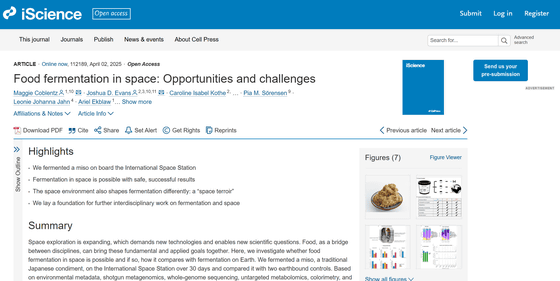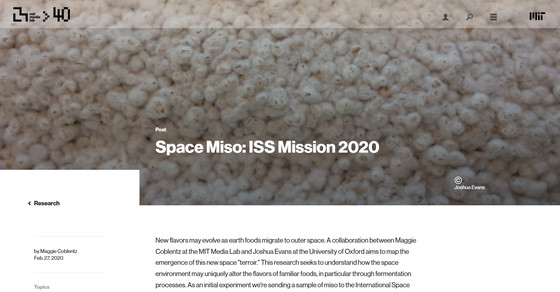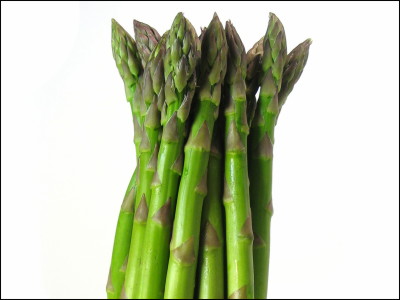What is the difference between 'Space Miso', miso fermented on the International Space Station, and regular miso? A research team from MIT and DTU announces the results of six years of research

A report on a joint study to explore the possibility of food fermentation in space by Maggie Koblenz, a researcher at the Massachusetts Institute of Technology (MIT) Media Lab, and Joshua Evans, a senior researcher at the Novo Nordisk Foundation Biosustainability Center at the Technical University of Denmark (DTU), was published in the academic journal iScience. In this experiment, Japanese miso was used as a representative fermented food, and the research team succeeded in fermenting miso on the ISS for the first time.
Food fermentation in space: Opportunities and challenges: iScience

Space Miso: ISS Mission 2020 — MIT Media Lab
https://www.media.mit.edu/posts/space-miso/

During long-term space stays, technology is required to ensure a stable supply of food from limited resources, and one such technology that has attracted attention is 'food processing using fermentation.' Fermentation is a method of changing raw materials through the action of microorganisms, which can improve shelf life and create flavor. In addition, since it does not require cooking processes such as heating, it is considered one of the technologies suitable for space, where resources are highly restricted.
The research group led by Koblenz and Evans began a research project in 2019 to test food processing through fermentation on the International Space Station in order to 'verify whether fermentation proceeds normally in space and to clarify the differences between the environment on Earth.'
In this study, Japanese miso was chosen as a sample of fermented food. According to the research team, in space, the distribution of bodily fluids in the body changes due to the effects of microgravity, and astronauts have been reporting that their sense of taste has become dulled and they can no longer smell. Therefore, they placed emphasis on umami, a taste that is easily sensed by humans, and chose miso, which is rich in umami components and highly nutritious, with the aim of increasing the satisfaction of meals in space.
On March 7, 2020, a sealed container containing the ingredients for miso was sent to the ISS by SpaceX's CRS-20 resupply ship. The miso was fermented on board the ISS for 30 days before being returned to Earth in early April of the same year. At the same time, similar fermentation was carried out on Earth using the same ingredients in two locations: Cambridge, Massachusetts, USA, and Copenhagen, Denmark, for comparison.

The miso on the ISS is called 'Space Miso.'
ISS Research Highlight: SEI space gastronomy lead,
@MaggieCoblentz , prepared a special miso experiment with @joshdevans for a 30 day fermentation duration on the @Space_Station . This work explores the future of food for extreme environments and was recently featured in @WIRED ! pic.twitter.com/YdWG0CPJRr — MIT Media Lab Space Exploration Initiative (@ExploreSpace_ML) March 11, 2020
Sensors were installed in the fermentation vessels aboard the ISS to record environmental data such as temperature, humidity, air pressure, and radiation levels. The average temperature on the ISS was 36.3°C, which was higher than on Earth. This temperature may have affected the fermentation rate and the compounds produced.

Analysis of the fermented miso, including the type of microorganisms, genetic mutations, volatile aroma components, and amino acid composition, confirmed that the miso fermented in space was recognizable as miso in appearance, smell, and taste, and that fermentation had been successful. In addition, the miso fermented in space was found to have many fragrant aroma components such as pyrazines , indicating that fermentation had progressed to a high degree. Furthermore, the gene sequence of the koji fungus showed more mutations than on Earth, and the research team pointed out that this may be due to the influence of the radiation environment in space.
The research team emphasized that this experiment showed that fermentation technology can be applied in space. In the future, they are developing a dedicated fermentation laboratory on the ISS so that stable food fermentation can be performed even in limited environments. The research team also argued that this research will help understand the behavior of microorganisms and changes in ecosystems in space.
In addition, Space Miso brought back from space was used as an ingredient in a dinner course by Kim Wegendorp, a DTU researcher who has worked as a chef for over 20 years, and the research team including Evans and Coblentz made it into grilled miso.
A Space Miso Dinner — MIT Media Lab
https://www.media.mit.edu/posts/space-miso-dinner/

Related Posts:
in Science, Food, Free Member, Posted by log1i_yk







